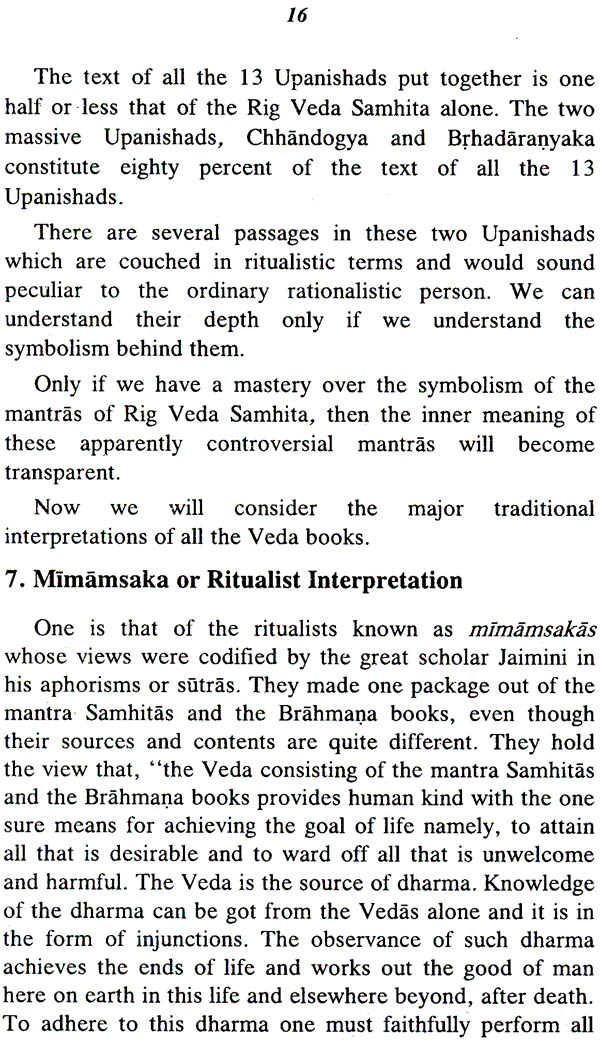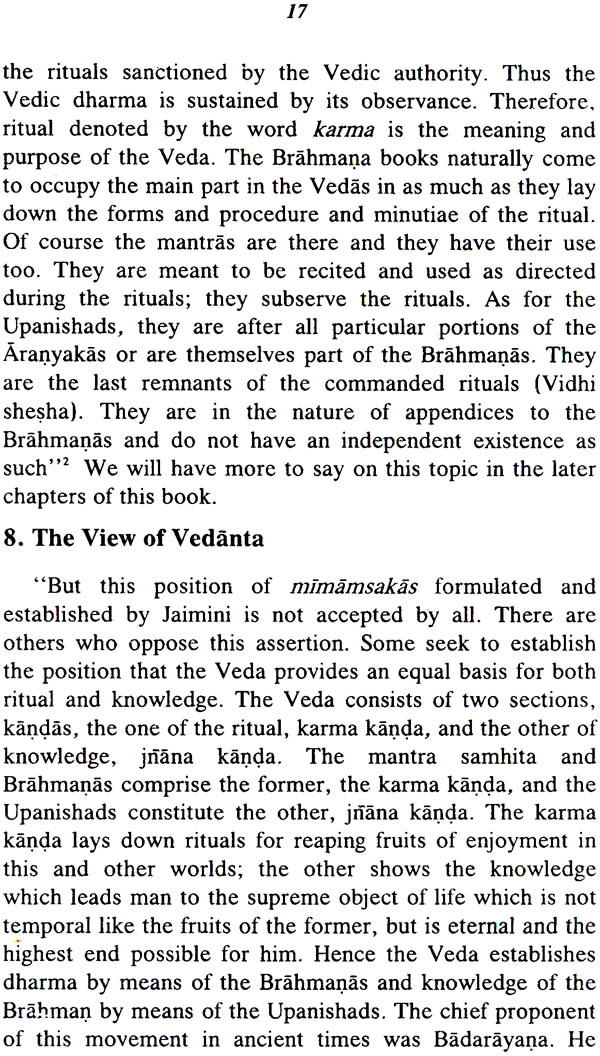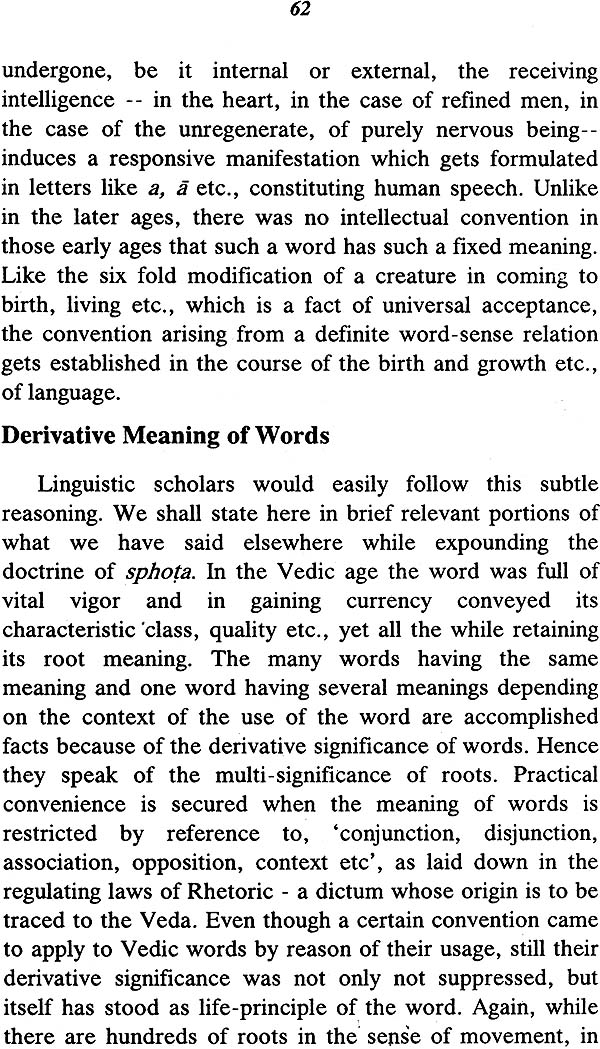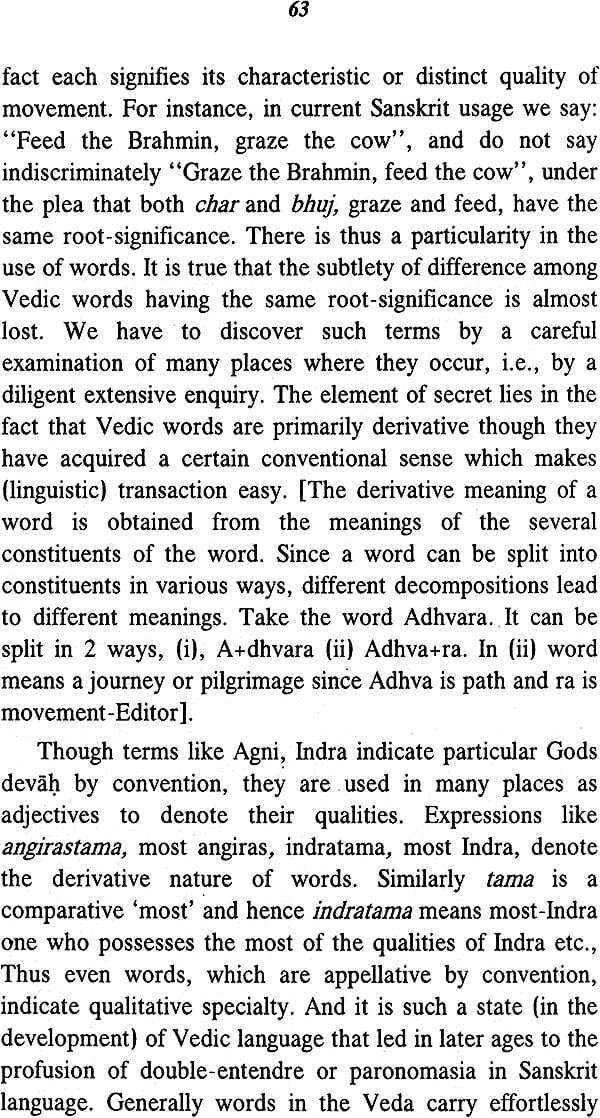
The Light of Veda (A Practical Approach)
Book Specification
| Item Code: | NAF400 |
| Author: | R.L.Kashyap |
| Publisher: | Sri Aurobindo Kapali Sastry Institute of Vedic Culture |
| Language: | English |
| Edition: | 2021 |
| Pages: | 88 |
| Cover: | Paperback |
| Other Details | 8.5 inch x 5.5 inch |
| Weight | 100 gm |
Book Description
The brilliant intellect of Sri T.V. Kapali Sastry is Patent in his writings, English, Tamil and Telugu published in 12 Volumes. His magnum opus, ‘Siddhajana’ commentary on the first Ashtaka of Rig Veda, explores the hitherto neglected psychological and spiritual sides of the ancient hymnal.
After a life-long study, verification in personal inner life and confirmation in other branches of Indian Wisdom, he began writing his commentary on the Rig Veda in his sixtieth year (1945). In his Bhumika, Introduction, he presents his approach, deriving from ancient rishis like Yaska, modern seere like Sri Aurobindo. He works out his psychological interpretation guided by the principles of the mystic symbolism of the Vedic rishis in his verse-by verse explanation. He finds astonishing echoes of the Veda in the tantra, in thought and in practice. He holds that the tantra is as old as the Veda and both and a common origin. He lays bare the secrets of some of the legends in the Purana.
The book is compiled from the author’s translation of his own Sanskrit work Siddhanjana-Bhumika published in 1952, several of the author on Vedic topics and some expository material on the Vedic texts.
The book is aimed at persons who are interested in understanding the deeper spiritual meaning of the Rig Veda Samhita and other Vedic books. Potential readers could be of two types: those who have no knowledge of the Vedic Sanskrit and/ or have no prior knowledge to the Vedic texts, and those who have some exposure to a spiritual interpretation like that of Sir Aurobindo or have some back ground in Vedic texts.
The book contains only a small part of Sri Kapali Sastry’s works. For readers seeking additional information, we suggest the larger compilation, “Unveiling the Light in the veda” which is also in English.
There are many readers who respect the spiritual view developed by Sri Aurobindo, but doubt that the spiritual interpretation can be given for all of the ten thousand verses. Kapali Sastry took up the challenge and has given the deep meaning for the first 1400 verses. We had to wait till the twentieth century for this achievement, even though the greatness of Rig Veda has been mentioned by so many authorities .
Rig Veda samhita is perhaps the most ancient book in the word. It is a work of metrical poetry having about one thousand hymns, suktas or about ten thousand verses or mantras. It is written in vedic Sanskrit which is quite different from the classical Sanskrit great poets like Kalidasa or Vyasa. It is dated prior to 4000 BCE based on various types of evidence.
On this book, there are more than twenty commentaries or bhashya in classical Sanskrit, each bhashya discussing several or all hymns. The earliest one is Yaska circa 2000 BCE or earlier, the latest one latest one is due to Sri T.V. Kapali Sastry (1886-1953). Obviously the different commentators viewed the rig veda samhita in different ways. The earliest known commentator Yaska mentions the existence of several schools of interpretations such as logical nayyayika, mythological, itihasika, ritualist, yajnika, nature-powers, adidhauta and spiritual, adidhauta. He regards the spiritual interpretation as the highest. The importance of the spiritual interpretation is emphasized in many ancient works like bevata, Mahabharata, brahmana book and Upanishads.
The is the first, the central teaching: the central aim, with which accords all the rest in the veda, is the seeking after the attainment of the Truth, Immortality and light. There is a Truth higher and deeper than the truth of the outer existence, there is a Light greater and higher than the Light of human understanding which comes by extraordinary and transhumant sight, hearing. There is Immortality and towards which the human soul has to rise. We have to find our way to that and get into touch with that Truth and Immortality. We have to be newborn into the truth, to grow in it, to ascend in spirit into the World of Truth and live in it. Such a realization alone is to pass from mortality to immortality, to unite with the supreme Godhead.
Here is the second doctrine of the Mystics: there is an inferior truth of this world because it is mixed with much falsehood. There is another higher truth, the Home of Truth, the Truth, the Right, the Vast as taught in the mantras. True knowledge there is termed rta-chit, Truth-Consciousness. And there are other worlds, but the highest is the World of Truth and light. This is the world celebrated as the svar, the Great Heaven.
And this is the substance of the third doctrine:
In the world-journey out is a battlefield of the devas and auras, the gods deva are the powers of truth, light and Immortality and the Powers of the opposing darkness. These are vrtra, vala the pains, the Dasyus and their kings. We have to call in the aid of the Gods devah to destroy these powers of Darkness who cover the light. We have to invoke the Gods devah in the inner sacrifice by the voice potent with the power of the Mantra. To them offering of whatever is ours is made; receiving all that is given by them in return, we shall be enabled and competed to ascent the path towards of the goal of all round perfection and bliss.
Finally, this is the supreme secret of the Vedic rishis : At the summit of all the mystic teaching is “The One Reality”, ‘that one’ which later became the central goal of the rishis of the Upanishads, taught with explanation in detail.
| Note of Readers | IV | |
| Extended Summary | X | |
| Abbreviations | XIII | |
| Note of Transliteration | XIV | |
| 1 | Overview of Vedas | 1 |
| 1 | Grouping of books | 2 |
| 2 | Names of the Books | 3 |
| 3 | Four Mantra-Samhita Books | 5 |
| Rig Veda Samhita | 7 | |
| Yajur Veda Samhita | 8 | |
| Sama Veda Samhita | 9 | |
| Atharva Veda Samhita | 10 | |
| 4 | Legend of Varaha and Brahmana Books | 11 |
| 5 | Aranyaka books | 14 |
| 6 | Upanishads | 14 |
| 7 | Mimamsaka or Ritualist Interpretetion | 16 |
| 8 | The View of Vedanta | 17 |
| 9 | View of Sayana | 18 |
| 10 | Notes | 18 |
| 2 | Spiritual Interpretation and the Symbolism of Yajna | 19 |
| 1 | Questoins Posed | 19 |
| 2 | Essence of the Spiritual Interpretation | 20 |
| 3 | Two - fold meaning of Mantras | 22 |
| 4 | Spiritual interpretation of the Riks: | 26 |
| Some Examples | ||
| 5 | The Symbolism of Riks Conveyed by Double Meaning | 28 |
| Double Meaning | ||
| 6 | The Outer Ritual Yajna and its inner or Subtle Counter Part | 29 |
| 6.1 | The Symbolism of the Priests | 30 |
| Hotr Priest: Summoner | 30 | |
| Adhvaryu Priest: Adhvara Menas Journey | 31 | |
| Udgata Priest | 32 | |
| Brahma Priest | 32 | |
| 6.2 | Symbolism of offerings | 32 |
| 6.3 | Result of the Yajna | 34 |
| 7 | Symbolism of thewords | 35 |
| 8 | The Four Key Ideas in the Secret of the Veda | 37 |
| 9 | Conclusions | 38 |
| 10 | Notes | 39 |
| 3 | The Mantra: Its Nature and meaning | 40 |
| 1 | Unusual Nature of Rig Vedic Poetry | 41 |
| 2 | Mantras themselves Reveal the Secret | 42 |
| 3 | Eternality of the Veda and the Role of Rishis | 44 |
| 4 | Yaska and Brhad Devata on the Mantra | 45 |
| 5 | Use of veda for Attaining Objects | 46 |
| 6 | Speciality of the Rig Vedic Poetry Notes | 49 |
| 7 | Notes | 49 |
| 4 | The method of intiation, Diksha | 51 |
| 1 | Agni, Kindled, Grows by Himself | 53 |
| 2 | Notes | 56 |
| 5 | Conclusions | 57 |
| 1 | Veda is a record of spiritual experiences, not Dialectics | 57 |
| 2 | Notes | 59 |
| 6 | Appendices | 60 |
| 1 | Two - fold meaning of Mantras | 60 |
| 2 | Human sacrifice in the Books | 66 |









